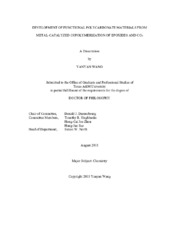| dc.description.abstract | Using the abundant, nontoxic and inexpensive CO2 as a renewable C1 feedstock, the catalytic coupling of CO2 and epoxides has provided an attractive method for preparing polycarbonates. This dissertation will highlight the development of CO2-based functional polycarbonate materials through rational monomer/polymer design and efficient post-polymerization modifications.
First, a straightforward and simple approach to synthesize amphiphilic CO2-derived polycarbonates with controllable block lengths, narrow molecular weight distributions and various functionalities was developed. Sequential copolymerization of propylene oxide (PO)/CO2 and allyl glycidyl ether (AGE)/CO2 under ‘immortal polymerization’ conditions yielded well-defined triblock polymer. The clickable alkene groups were then modified by radical mediated thiol-ene click chemistry to install various water-soluble moieties onto the polymer backbone. The resulting amphiphilic polycarbonates underwent self-assembly in deionized water to form well-dispersed micelle structures with distinct surface charges, providing the first examples of constructing functional nanomaterials from CO2-based polycarbonates.
To expand the repertoire of polycarbonate biomaterials, a carboxylic acid functionalized polycarbonate was synthesized. Specifically, tert-butyl 3,4-epoxybutanoate was copolymerized with CO2 using bifunctional cobalt(III) salen catalysts. Hydrolysis of the resultant polymer affords poly(3,4-dihydroxybutyric acid carbonate) (PDHBAC). Notably, PDHBAC was shown to undergo complete degradation in basic
aqueous solution into nontoxic biomasses including -hydroxy--butyrolactone and 3,4-dihydroxybutyrate. In addition, PDHBAC was employed as a degradable scaffold for platinum conjugation via an aspartate or glycine-aspartate linker; platinum loadings of 21.3-29.5% were achieved.
Lastly, in efforts aimed at improving the thermal mechanical properties of CO2-based polycarbonate materials, cross-linked polycarbonate films were prepared from PO/AGE/CO2 terpolymers containing clickable alkene groups. Detailed kinetic studies of terpolymerization of PO, AGE and CO2 revealed similar reactivity ratios between the two epoxide monomers, indicating that the vinyl group distributed randomly along the polymer backbone. Terpolymers of PO/AGE/CO2 were then treated with multifunctional thiols to afford well-defined cross-linked networks. Investigation of the relationships between film compositions, structures and thermal mechanical properties was carried out using dynamic mechanical analysis. | en |


